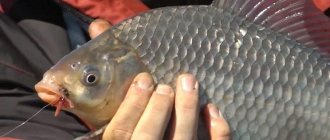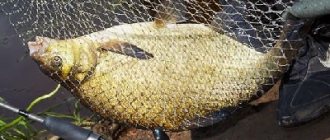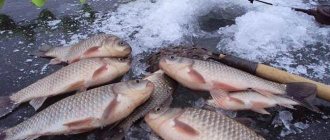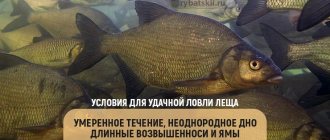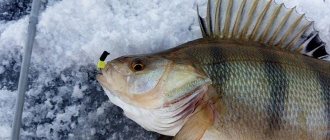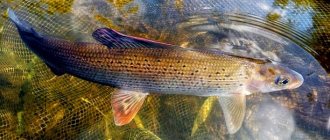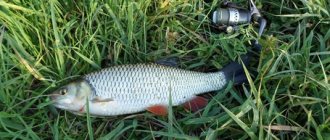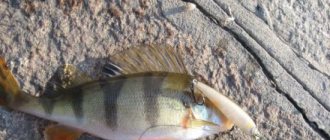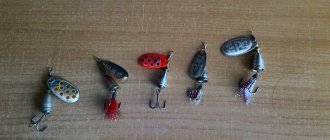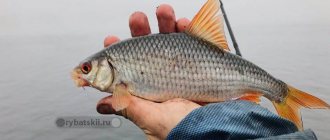Pike is the most important object in terms of spinning fishing, and its fishing with a spinner is the initial stage in the evolution of spinning fishing. Many fans of fishing using this method most often use all kinds of spoons for fishing, which can be purchased in almost any fishing store or online store.
Appearance and characteristics of pike
Pike are fish that belong to the pike family. This fish is common in fresh water bodies in North America, Europe and Asia. Fish most often live near the coastal zone near all kinds of aquatic thickets in low-flow and non-influent waters.
The total body length can even reach 1.5 m in length, and reach a mass of up to 35 kg (in most cases, about 8 kg in weight and up to 2 m in length). In general, the body is torpedo-shaped, the head is elongated and large, and the mouth is wide.
The color itself is variable and directly depends on the environment: regardless of the degree and nature of the development of certain vegetation - the most common are gray-yellowish, gray-greenish, gray-brown, the back is dark, the sides with olive spots and large borers - they form transverse stripe.
But unpaired fins are yellowish-gray, brown and have dark spots, while paired fins are orange. Most often she feeds on the most common fish. Silver pike is also found in many lakes.
Males and females differ in the shape of the urogenital opening. In females it has an oval depression, which is surrounded by a red ridge. But in males it looks like an oblong narrow slit, the color of the belly.
The body has an arrow-shaped elongated shape. Her head is greatly elongated, but her lower jaw moves forward. On the lower jaw, the teeth have different shapes and sizes - they are intended to capture the victim.
But on other bones, the teeth are smaller and have sharp ends directed into the pharynx, and can also be buried inside the mucous membrane. Thanks to all this, the prey itself is very easy and if the victim tries to get out, the teeth in the throat rise and also hold it.
Description and behavior characteristics
Every fisherman knows what a pike looks like. A narrow, elongated body, a large head, a huge mouth lined with sharp teeth, a powerful tail that allows it to make sharp, unexpected throws. Pike reaches impressive sizes. Usually specimens weighing up to 6-8 kilograms are caught, although cases have been officially confirmed when specimens weighing up to 35 kg were caught. There are even legends that river predators were caught that weighed up to 15 pounds and reached a length of 5-6 meters. But these are nothing more than rumors, although in recent years the maximum weight of this popular fish has decreased. As a result of a decrease in the population due to the actions of poachers - fishing during spawning, predatory behavior towards eggs, the use of nets - catching even a 2-3 kg pike remains a pipe dream for many.
Like most predators, it remains active all year round, although in some months it becomes voracious and readily takes bait. Leads a predominantly nocturnal lifestyle - during the day, especially in the heat, it is not active. You can play with a spoon under its nose, but the fish will lazily move away and will not be tempted even by a wounded baitfish. Landing a pike is a delight, and you can't tell exactly how much a trophy weighs until it lands on the shore.
Habitats
Pike are sedentary fish.
For their habitat, as well as for hunting, they choose small areas, in most cases with a quiet current or without it at all, however, with the presence of a special pit, snag, steep ravine or any other place where it could hide from danger and also hide for further attack. Of their favorite “traps,” pike sometimes, when searching for food, prefer to go to places where fast currents predominate, or even go aground. A true characteristic feature is that each fish has its own permanent stopping place.
This fish leaves its sites for food against the current, especially at a time when the water is rising, although after a decline, it immediately returns. Only spawning can break this habit and force them to move away from their usual places somewhere further.
Features of pike fishing in spring
For small pike in the spring, time of day is everything.
In the spring, after the ice melts, pike begin to slowly move to their spawning grounds. Often their backs are visible from the water as they appear on shallow, vegetated floodplains of rivers, marshes, bays and large lakes. The pike then moves a little deeper to regain strength and wait for warm water. When this happens, they begin to feed.
In search of spring pike. Video report
How to choose a time and place for fishing in the summer?
In order to catch pike in the summer, you must definitely find the most optimal place. It is imperative to remember that in very hot weather, pikes tend to find the coolest place in the reservoir and try to be at the very bottom.
If there are no deep places, pikes move to thickets of grass and reeds. In the summer, she goes hunting either early in the morning or late in the evening. And here the main preferences are given to snags, lilies, bottom driftwood, water lilies, edges, pit boundaries, branches, dumps, and so on. Floating islands with grass or reeds are also worthy of special attention.
In the summer, the pike's bite is extremely uneven. Even the most common opinions that this predatory fish bites in the evening or in the morning are not always confirmed. Sometimes the bites are just great and they don’t miss a single bait.
Sometimes it happens that there is no bite at all and only random young or old pike are caught, simply caught on the bait. But on cloudy and thundery days, in rainy and windy weather, this fish becomes quite energetic. But even in changeable weather it will be good to bite for several days in a row.
Choosing a spoon: what should a fisherman take into account?
Pike fishing in summer has many features. The vast majority of fishermen believe that it is very difficult to catch pike in the summer and this is explained by the very hot weather and high water temperatures, but real connoisseurs of pike fishing in the summer know for sure that pike need to eat all the time, which means they can catch it. It’s enough just to know exactly what and where to catch pike in the summer.
Catching this fish also requires the correct and competent selection of bait. Each fish has its own preferences, especially in different bodies of water. In some of them, pike bite on bleak, crucian carp and live bait. In other reservoirs, pike bite only on wobblers. True, these “quirks” appear during sudden temperature changes.
Main types of spinners
Today, there are a huge number of all kinds of spinners for catching pike in the summer, which have their own characteristics and advantages. Moreover, you need to remember that you need to think through every purchase and only then make a purchase. It is recommended to first consult with highly qualified specialists who have extensive experience in this market segment. The most optimal and common options are described below:
- Acoustic . Acoustic spinners, when retrieved, emit sound signals that attract fish - that is, pike. There are all sorts of debates about the effectiveness of various acoustic special lures, however, experience and science prove that pike are not indifferent to possible noise, and also bite very well on a similar type of bait.
- Oscillating (oscillator) . Oscillators are capable of creating all sorts of oscillatory movements, as well as a visual image of a once wounded fish, to which pike instantly react. In the vast majority of cases, fish feel the vibrations of the spinners on the side line and after that they already notice the bait. True, sometimes they work very quickly and it is for this reason that the spinner itself must look as attractive as possible, and also withstand different ideal amplitudes when wired. All oscillating spoons are traditionally used in all kinds of reservoirs with relatively small or medium currents, as well as clear water. In such conditions, the shine of the baits and their movement are of maximum importance.
- Rotating (spinner). Spinnerbaits, in addition to the visual image of small fish, can create excellent noise that attracts pike as much as possible, and it is for this reason that all spinners work great in still and opaque water, even in very overgrown reservoirs, lakes and rivers. The shape of the rotating spinners significantly affects the principle of operation.
- Oblong thin. Such spoons perform well in modern conditions and strong currents, since they simply create minimal resistance to the water itself - this makes it possible to significantly hold the bait itself at the required depth for catching pike in the summer.
- Almost round in shape. All spinners that have an almost round shape are capable of creating noticeable resistance - they are excellent for all kinds of reservoirs where there is standing water, as well as slow retrieval. Such spoons are universal.
Colors of silicone lures
Date: January 23, 2021 | 189
The color of the silicone bait is one of the factors when choosing a specific rubber. One can argue for a long time about the importance of silicone color. Some people attach great importance to the choice of color, while others look almost dismissively at this parameter. The truth, as usual, is somewhere in the middle. Much in this matter depends on the fishing conditions, the breed, and the degree of activity of the fish. Well, since it is impossible to claim objectivity on such a controversial topic, in this article I will express my subjective opinion on various colors and features in their use.
The color of the edible and the color of ordinary silicone baits, which were at the height of fashion some 7-10 years ago, are in practice completely different palettes. Both the shape of rubber and their colors are evolving strongly and rapidly, multiplying and growing. For those interested in the topic of jigs and soft baits, these changes are very interesting.
It would seem that the color spectrum has been known for a very long time. But, at first, the manufacturers did not have enough desire or imagination. The usual set of colors for soft baits at that time was quite scarce. The favorites were: white, pearlescent, yellow, several shades of green, brown. Red and black also appeared, but somewhat less. Some colors had glitter, some without.
Here, for example, are the colors that were in use when I was just mastering jigs; I catch pike and perch with vibrating tails and twisters.
Then, two-color and three-color options appeared. For example, these.
Well, then it was time to eat. Yes, and the second wave of various ordinary silicone has arrived. And then it splashed from a rainbow fountain.
I see neither the point nor the possibility of describing each color. There are unique colors and shades from some manufacturers. Many colors are repeated. I will devote the rest of the article to analyzing a number of my favorite colors and the most popular ones, describing the conditions in which they work best for me.
Machine oil color . This is one of the most popular flowers among jigs, micro jigs and edibles. Brown, with a reddish or greenish tint. Sometimes sparkles are added to the material, shading the bait with one or another tint.
All forms of silicone baits are absolutely good in this color. Vibrating tails, twisters and medium-sized slugs in the color of machine oil are very good at catching pike perch. Various fishtails in this color are, for many anglers, including me, one of the best colors for perch.
Various peaceful fish also react very positively to baits in this color.
I especially like micro-twisters, small vibrating tails, micro worms and slugs in this color. Machine oil has a greenish tint, which is almost the natural color for crayfish. So, for this form of edible, “motor oil” is very appropriate.
Basically I use this color from the moment the water becomes sufficiently clear until the end of the season.
Shades of brown . Machine oil borders very closely with a wider palette of shades of brown.
These are also very catchy and popular colors. I use them somewhat less frequently than “machine oil,” but they have also proven themselves to be extremely good. It’s not bad when the material is translucent, with the addition of multi-colored sparkles.
In particular, the edibles in the Ebimiso Sp color palette from Reins work well for me.
LOX color . The famous color LOX from Reins is one of the shades of purple. Despite all the strangeness and seeming unnaturalness of this color, it works brilliantly in a pond. Many copies have been broken regarding the best colors of silicone lures. But, in my opinion, and the opinion of many, some of the best are: “Loch” and “Machine oil”. I don’t even see the point in trying to put one of them at the top. Sometimes one works better, sometimes the other.
Also, Raines has another variation of this color “Pink Lox”, with a pinkish appearance. Didn't notice much difference.
Don't think that only Reins has such a killer color. Many companies use very similar colors in their palettes. There are analogues for Lucky John, Bait Breath, Crazy Fish, and many others. In general, I often go by color by eye rather than by code. There are many manufacturers. Each has its own codes and color names. Keeping all this in mind is more difficult than simply navigating by visual perception.
Speaking of the best colors of edibles. Either “machine oil”, “Lox”, ash-black, or “olive” - all are dark, all are similar in color to benthic organisms, crustaceans, spiders, leeches, crayfish, etc. And the hue, tint, greenish, purple - only emphasizes the similarity with the living prototype. This, as I see it, is the secret of the catchiness of these colors.
White color . White color, light, both on its own and in combinations, is a color close to natural, to natural. In vibrotails, slugs, fish - this is an imitation of light, silvery colored fry. In the case of twisters, worms - imitation of whitish earthworms, larvae, maggots.
So this color is also very popular. I caught a lot of pike in lakes and bays using a light jig with small and medium vibrating tails in this color.
Also, white silicone baits are clearly visible in muddy water. So, this color should be used in the spring, on rivers. In muddy water, not only pike and perch respond well to white bait, but also chub, asp, and ide.
Pearlescent color . Mother of pearl is also very similar to white in nature and application. But, there were cases when catching the same pike, when mother of pearl greatly exceeded the usual milky white in the number of bites. Apparently the glare from this color, especially when applied to active baits, vibrotails and twisters, as well as fish, is very appropriate.
Translucent, light . Various highly transparent colors are especially good in clear, clean water. Many benthic organisms, especially in the early stages of development, have not yet acquired a chitinous shell, and look translucent, with translucent organs. So, the success of silicone in such colors is quite understandable.
There are colors of this type with a greater or lesser degree of transparency, with or without colored sparkles in the structure.
Ash color . In my personal rating, the translucent black color with glitter is one of the favorites, on a level with “machine oil” and “sucker”. In fact, these three colors make up my personal TOP 3 when choosing the color of an edible.
This color is well represented in the Blue Gill color from Keitech and Kosadaka DS, and many manufacturers also have analogues.
Black color . Pure black, for some reason, is noticeably inferior to the previous color option. But small twisters and large thick leech worms in this color are very good.
I would say that black lures especially make sense when it comes to contrast. A dark spot against the background of algae, against the background of a light sandy bottom, against the background of the sky - this provokes fish very well. So, I recommend placing absolutely black baits, first of all, in light, clear water.
Next, let's go through the main colors of the rainbow.
Red color . Despite all the similarity in color with bloodworms, worms, fish fins, despite all the stereotypes that a predator loves red because it is the color of blood, I have a frankly unimportant relationship with red silicone baits.
This food works well at shallow depths, up to 1-1.5 m, in clear water. Apparently, at greater depths, red is seen as dark gray, and there is no longer any color resemblance to the prey. So, I can recommend this color for shallow fishing.
There are red phosphorescent baits that accumulate light. They can be successfully used for deep-sea jigging. However, at depth nothing remains of their redness - only a glow...
Pink color . Pink lures are very popular for coastal fishing in the sea (rock fishing), as well as for trout fishing in clear lakes and streams.
Sometimes this color of bait works very well for pike perch and pike perch. Despite all the glamor, these colors worked much better for me than red.
Pink is an excellent provocateur color, a representative of bright colors. Accordingly, in addition to clear water, this coloring can be successfully used in muddy water and on a passive predator that needs to be stirred up and shocked. In particular, such a bright unnatural color can help with this.
Orange. Carrot . The carrot sometimes, very infrequently, but it works and shoots. I'm not a big fan of this colorway. But, as second-tier baits, I have carrot-colored silicones and from time to time they help out.
Yellow. Lemon . In the era when pike perch and pike were caught using classic jigs and vibrating tails, yellow was one of the most lethal and catchy colors. And even now, if you fish with an ordinary jig using the old classics, then it remains so.
However, this color does not appear so often in modern edible silicone baits. And, it seems to me, yellow, for some reason, turns out to be one of the colors that has most lost its position and popularity. I don’t know, maybe it’s not so for someone. But this is exactly the picture I get. If I fish with active baits, vibrating tails, sometimes with twisters, then the yellow color is in use. When it comes to other forms of edibles, its place is very insignificant. A strange phenomenon.
Salad color . About the same story as with yellow. This color works very actively in vibrotails and twisters for active pike and pike perch, especially in not very clear water.
In the format of worms, slugs, crayfish, somehow these colors didn’t work for me.
Dull green . Green with a haze of white and yellow. This was the color of the first vibrotails on which I started catching pike, mastering jig fishing. And now, when it comes to catching catfish, I also take baits of this color with me and use them.
Edibles in these colors, in my opinion, are somewhat more interesting than just yellow or bright green. But, again, this is just my subjective opinion.
Green color . Shades of green are a very good and popular color. Of course, in heavily overgrown places, near algae, this color is lost. But, on a relatively clean bottom, on rocks, on sand, on clay, among snags, it is quite possible. In some cases, dark green colors are in no way inferior to other dark classics.
I would especially note the olive tint of the baits. And also, green colors, additionally saturated with sparkles.
Shades of blue . To be honest, I still haven’t warmed up to the blue colors of silicone... But when jigging pike perch at extremely great depths, it makes sense to try such colors.
Purple color . Well, in fact, purple and its shades are the closest “relatives” of the already mentioned color “LOX”. So it works well!
Combined coloring pages . Many silicone baits have multi-colored colors designed to emphasize realism, to almost photographically recreate the living food object that this or that bait imitates. Of course, these colors are most appropriate when imitating a fish. Less commonly, for shrimp and crustaceans.
Contrasting color combinations . Also, very often there are combined colors based on two or three colors. For example, this is a contrasting coloring of the back and abdomen of a silicone fish, vibrotail, slug.
A red spot, or other contrasting spot in the head or tail of the bait is a good technique. And here the point is not so much in the redness of the spot, but in its contrast. It turns out that the attack point for the fish is highlighted in color. It is for this purpose that many fish imitations have living three-dimensional eyes.
Presence of sparkles . It cannot be said unequivocally that the presence of glitter increases catchability. But the presence of sparkles of one color or another in the material, of course, enriches the palette.
Phosphorescent colors . There are baits in which the material has light accumulating properties. As a rule, these are white, yellow, green or red baits. At great depths, in the dark, they glow.
And now, a little physics. Different parts of the light spectrum, different colors, behave differently in water with increasing depth. This is due to the refraction of a ray of light on the surface of the water. And the thicker the layer of water, the greater the depth at the observation point, the fewer visible colors remain.
The red one disappears first. So, red baits lose all meaning deeper than 1.5-2m. And in muddy, dark water, even higher, about 1 m. Further, at the level of 3 meters, orange disappears. At 4-5m - yellow. Green works up to 6-7m. Blue and purple also work at depths that are almost limiting for jigs, up to 10m and a little more.
So, in addition to the recommendations for choosing silicone colors discussed in the material, you can correlate your choice with the depths at which you plan to fish.
Share with your friends:
Categories: Edible · Tags: Lures, Edible, Color
What color of spinner to choose for pike fishing?
It all directly depends on what weather you are fishing in. If the weather is changeable, then you should choose bright lures and baits, but if the sun prevails, it is recommended to use larger and darker ones - they will be much more noticeable.
When choosing the color of the bait, it is best to purchase silver, but with a matte finish.
Indeed, when choosing the color of the bait, it is best to purchase a silver one, but with a matte finish; it is recommended to pay attention to the fact that pikes “don’t like” reflections and so on. The best option is a variety of silver spoons, which are covered with a special matte coating. And they are much more noticeable - especially on sunny days. In principle, they can be considered universal, as they are suitable for spring and autumn fishing.
From the second half of April, pike are found at shallow depths. It is during this period that copper-red spoons are best suited for good fishing.
Taking into account the fact that this type of fish mainly feeds on various types of large fish, their size should be from three to ten centimeters. It is especially important to consider that copper-red spoons are better suited for good fishing. They are simply excellent in terms of successful fishing in a given period of time.
From September until winter, pike do not show any particular preference for the color of the bait.
From the very beginning of September until the onset of cold weather and winter, the color of the bait itself does not give away. With all this, pike consistently bite not only on red ones, but also on silver, gold, yellow, white and so on. But the most optimal solution is combined gear. It is also recommended to combine them with all kinds of multi-colored petals, in which one side is white, but the other is yellow.
In autumn, dark-colored lures practically do not produce results.
In general, as practice shows, in the autumn the spinners themselves, which are dark in color, actually do not give any result at all.
Lures for the winter
In winter, pike goes closer to the bottom and becomes inactive. It is becoming increasingly difficult to catch it, because practically no light penetrates through the thickness of the cold water. The best colors for pike are fluorescent, they have high catchability in dark conditions. It is better to choose a slow and calm retrieve for a spinning rod, since the predator prefers to conserve energy in the cold season.
If fishing takes place under ice, it is generally irrational to think about choosing the color of the bait. Even if the bait glows, lazy fish are difficult to attract with visual stimuli during this period.
The choice of odorous bait or feeding is important. In low light conditions, it is much easier to interest a predator with scent rather than color. It should also be remembered that if pike perch bites on the bait, then you should look for another place to catch pike. These fish compete for territory and are not found within the same area of the reservoir.
Glowing baits are suitable for winter fishing
Advice from experienced people on choosing a “working” spinner
In fact, there is a huge number of different tips that relate to the selection of gear.
- A world-famous company is a guarantee of quality. In fact, a world-famous company is not always a guarantee of quality. For each person (fisherman), it will be more convenient to use a certain type of spinner. But large companies that produce spinners take their reputation very seriously.
- Choose based on fishing conditions. Before you go fishing, you should definitely take into account the fact that the spoon must fully comply with the fishing conditions.
- Your kit should have several types of spoons of different colors in order to choose them according to the lighting and water transparency . You should definitely take into account the fact that at the moment you must have several different baits with you.
- The first time you visit any body of water, experiment with it . This is the main condition for successful fishing. It is very important to experiment here as the weather can change. And it is very important to use different spinners.
Most popular models
The most common and popular lures among fishermen are described below.
Mepps Syclops
It is a very common and popular spinner, which is best suited for catching pike in the summer.
Dam Effzett
It is a fairly convenient lure that meets all the requirements, but it has one significant drawback - its weight, which is quite large.
Blue fox esox
A very light and comfortable spoon, which is most suitable for fishing in summer, especially on sunny days.
Lucky Craft Spin Board
In general, the Lucky Craft Spin Board is an excellent spoon, which is suitable for fishing late in the summer - towards the evening.
Kuusamo Professor
The Kuusamo Professor spinner is very light and has a very comfortable color, thanks to which it is possible to catch medium or small pike.
Williams Vabler
This is an excellent spoon that fully meets all the requirements and allows you to catch even heavy pike.
Rublex Orkla
This is the best spinner, thanks to which you can catch even a trophy specimen of pike. By the way, you can catch any fish with this spoon.
Daiwa Silver Creek Spinner RC
This is an extremely simple and very light spinner, which is suitable for fishing in the cleanest and most unovergrown reservoirs.
Abu Garcia Tobi
It is quite affordable and extremely simple, and at the same time, it belongs to the economy class category. As for the fishing technique, it is universal.
Pontoon 21 Ball Concept
One of the best spinners, thanks to the use of which it is possible to catch an excellent specimen. It has a balanced look and a comfortable shape.
